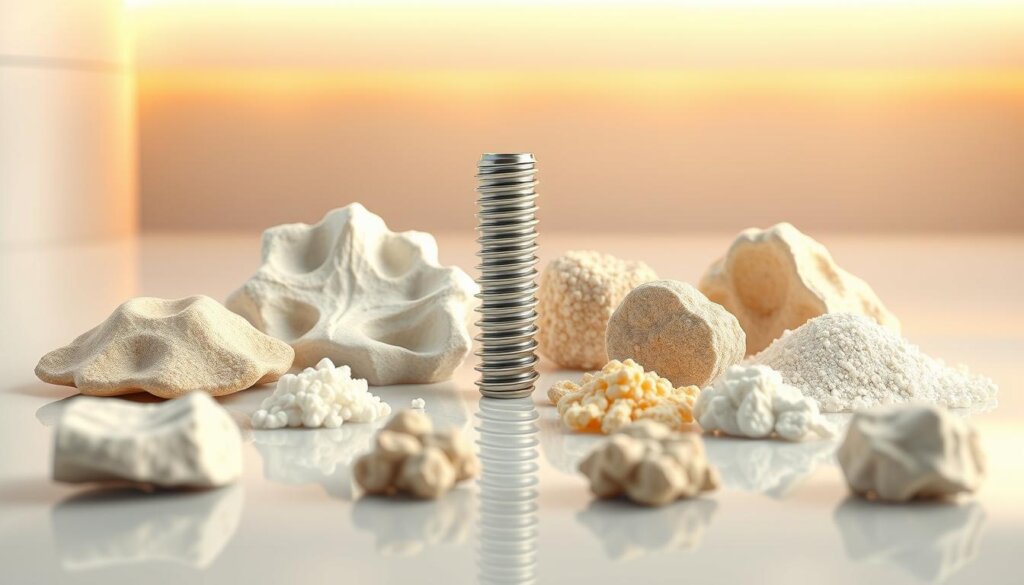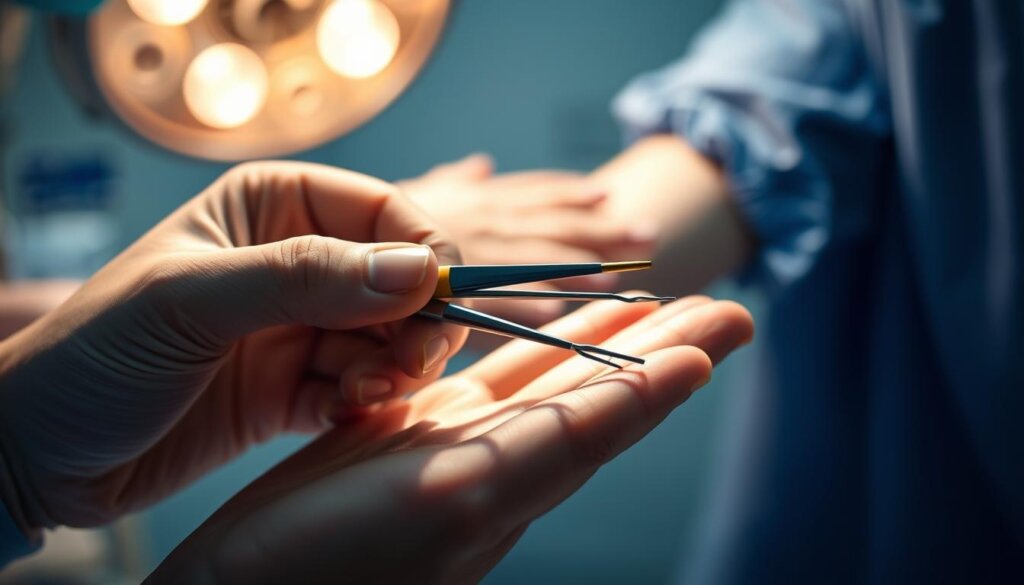Why Do I Need a Bone Graft for Implants?
Every year, 5 million people in the United States get dental implants. What many don’t know is that before many of these implants, a bone graft is needed. But why do I need a bone graft for implants, especially for dental health? It’s key for making sure the jawbone is strong enough for implants.
Think of the jawbone as a building’s foundation. Just like a strong foundation is needed for a stable building, a healthy jawbone is necessary for dental implants. If the jaw loses bone, it’s not only about filling a gap. It’s about building a strong base for the implant’s stability and longevity. Bone grafts are crucial for the success and lasting health of dental implants.
Bone grafts help the implant and bone to fuse together. They create a strong base that supports the implant and helps bring back function and looks. For those wanting their smile and confidence back, dental implant preparation bone graft is the first step towards dental renewal.
Key Takeaways
- Dental bone grafting is a critical step for ensuring the success of dental implants.
- Bone grafts are necessary when jawbone loss could jeopardize the stability of an implant.
- Bone grafting dental implants can improve both function and aesthetic outcomes following tooth loss.
- Understanding why do I need a bone graft for implants is central to grasping the full scope of implant surgery.
- The process forms the foundation for stronger, more durable dental restorations.
Understanding Bone Grafting
Bone grafting is key in dentistry for helping bones grow, making room for dental implants. It helps keep the face’s shape by encouraging the jawbone to grow naturally.
What is Bone Grafting?
Bone grafting adds new bone to areas of the jaw with bone loss. It aims to create a strong base for dental implants. This process helps dental implants feel and act like natural teeth.
Types of Bone Grafts
- Autografts: Bone taken from the patient’s body, often from the chin or hip.
- Allografts: Bone from a donor or cadaver, tested and treated for safety and compatibility.
- Synthetic Grafts: Artificial materials that act like real bone, helping it grow and heal.
Benefits of Bone Grafting
Bone grafting for dental implants offers many advantages. It doesn’t just help bones regenerate for implant support; it also stops more bone loss. This keeps your mouth healthy and looking good. Plus, it helps dental implants last longer and keeps your jaw and mouth working well.
| Benefit | Description |
|---|---|
| Prevents further bone loss | Keeps the bone stable, stopping damage that could affect nearby teeth and implant success. |
| Supports implant success | Builds a strong and healthy jawbone needed for dental implants to attach and last. |
| Enhances facial aesthetics | Helps keep the face’s natural shape, avoiding the look of tooth and bone loss. |
The Need for Bone Grafts in Dental Implants
The importance of bone grafts in dental implants is huge. They are key when looking at importance of bone graft for implants, jawbone deterioration, and dental implant success. Patients with low bone density often need bone grafts before getting implants. This is due to diseases or changes in their bodies.
Many face jawbone loss from tooth loss, gum disease, or injuries. Without natural teeth, the jawbone gets weaker over time. It happens because the jaw lacks the stimulation from natural teeth. This weakening can make it hard to place implants securely.
Knowing this highlights the importance of bone graft for implants. Dentists use bone grafts to rebuild lost bone. This makes a stronger base for the implants. It’s key for both the implants’ physical support and their lasting success.
A CT scan is often the first step in tackling bone loss. It helps in creating a grafting plan that fits each patient. This customized approach boosts the dental implant success rate. It meets the immediate look the patient wants and ensures their mouth’s health for years to come.
The Role of Bone Density in Implants
How firm and thick your jawbone is, known as bone density, is key for dental implant success. It’s crucial to know how bone density for dental implants influences their success. A strong jawbone is essential for the implant to bond properly, affecting healing times and the final result.
A higher bone density means a better chance for the implant to be successful. It provides stronger support. But if the density is low, there might be problems or the implant might fail. This shows why a healthy jawbone is vital.
Understanding and keeping a healthy bone density is critical for implant success and durability.
Let’s look at the role of bone density in healing after getting an implant:
What is Bone Density?
In dental health, bone density refers to how strong and solid your jawbone is. It depends on how much bone mineral is in the bone. Good bone density means the jawbone can properly hold dental implants. This is often true if you don’t have bone loss diseases like osteoporosis.
How Bone Density Affects Healing
During healing, osseointegration, or how the implant fuses with the bone, is crucial. A denser bone gives more area for the implant to attach, creating a stronger hold. This makes recovery quicker and improves the chance of a successful implant.
For the best bone density, think about your calcium intake, vitamin D, and overall diet. Regular doctor visits and early action can help keep or boost bone density. This makes sure your jawbone is ready for implants, leading to better results for those getting them.
Evaluating Your Candidacy for a Bone Graft
Before getting dental implants, knowing if you need a bone graft is key. It’s essential to check if your jawbone can support the implants. Knowing how your bone health impacts this decision can show if you might need this process.
Age, dental history, and conditions like gum disease all affect bone quality. This matters a lot for implant stability. Over time, losing too much bone can really affect whether a bone graft will work. Here, advanced imaging helps give a clear view.
- Complete Oral Examination: First, a dental expert will thoroughly check your mouth.
- Imaging Tests: Tech like cone-beam CT scans show detailed images of your jawbone’s state.
- Medical History Review: They’ll also look closely at your dental history and any health issues that could influence bone growth.
When evaluating, here’s what they focus on:
- How much bone you’ve lost and why
- If any infections or diseases could slow bone healing
- Your past dental treatments and records
This careful look helps experts suggest the right treatment plan. By correctly evaluating bone health for implants, they ensure the implant’s success. They aim for great functional and visual results for the patient.
The Bone Grafting Procedure Explained
It’s key to grasp the bone grafting steps for implants, for patients and dentists alike. We’ll dive into the preparation and procedure details needed for a successful implant surgery.
Dental implant surgery preparation begins long before the actual surgery day. Good planning is crucial to make sure the implant works well and keeps the mouth healthy.
Pre-Procedure Preparation
Getting ready for a bone grafting procedure involves several steps:
- Thorough dental and medical checks to see if surgery is okay.
- Imaging tests like X-rays or CT scans to check bone quality.
- Talking about anesthesia choices for comfort during surgery.
- Maybe taking antibiotics or other meds to avoid infection after.
- Advice on not eating or drinking before surgery.
Step-by-Step of the Procedure
The bone grafting follows a detailed process for placing the graft material right:
- Anesthesia is given for comfort.
- An incision is made at the site for the bone graft material.
- The bone graft material is placed, coming from the patient, a donor, or synthetic options.
- The cut is sewn up to help with healing.
- Care instructions for after surgery are shared to help with recovery.
Deep understanding and thorough preparation for dental implant surgery are vital. They help make sure implants last long and improve overall mouth health.
Recovery After a Bone Graft
The time after a bone graft is key for the implant’s success. It involves careful steps and monitoring. This ensures the bone graft healing process goes well. Knowing what this recovery involves and how to care for yourself can really help.
What to Expect Post-Operation
The recovery can take from a few days to weeks, based on the graft size and how you heal. You may have some swelling and discomfort. But, medications can help with this. Make sure to follow post-operative care for bone grafts directions to avoid any issues.
Tips for Accelerated Healing
- Maintain good oral hygiene to prevent infection.
- Adhere strictly to dietary guidelines provided by your surgeon.
- Avoid smoking and other activities that could negatively impact healing.
- Attend follow-up appointments for proper assessment of healing progression.
Below is a detailed list of dos and don’ts during recovery. This can help optimize the bone graft healing process.
| Recommended Activities | Activities to Avoid |
|---|---|
| Gentle oral hygiene with prescribed products | Chewing on the site of the graft |
| Eating soft foods as advised | Smoking or using tobacco products |
| Using ice packs to reduce swelling | Engaging in strenuous physical activities |
| Regular follow-ups with the dental surgeon | Ignoring signs of infection or unusual pain |
Alternatives to Bone Grafting
Bone grafts have long been key for dental implants. But now, we have synthetic bone grafts and other alternatives. This is great news for patients who can’t get regular bone grafts or want something less invasive.
Synthetic bone grafts are a big step forward in medicine. They’re made from materials that work well with our bodies to help bone growth. They’re fantastic because they don’t require taking bone from the patient or a donor. This lowers infection risks and speeds up recovery.
Sometimes, bone grafts and regular implants just aren’t possible. That’s where alternative solutions to bone graft for implants come in. We can look at dental bridges or dentures instead. These options don’t need bone grafting. They are good for people who don’t want surgery or can’t have it.
| Alternative | Description | Benefits |
|---|---|---|
| Synthetic Bone Grafts | Use of biocompatible materials to mimic natural bone growth | No need for donor site, lower infection risk, quick recovery |
| Dental Bridges | Prosthetic tooth attached between two natural teeth | Non-surgical, cost-effective, shorter preparation and treatment time |
| Dentures | Removable replacement for missing teeth and surrounding tissues | No surgery required, cost-effective, adaptable to changes in bone structure |
These breakthroughs make dental care more comfortable for patients. They open up more options for all sorts of dental problems. This means care that’s more focused on the patient. Keeping up with these developments can change treatment results. It leads to happier patients and better oral health.
Risks and Complications of Bone Grafting
Bone grafting is key for patients needing dental implants. It improves functionality and looks. Yet, it also comes with challenges. Understanding the bone grafting risks and how to minimize complications in bone grafting is crucial for success.
Risks like infection, nerve damage, or graft rejection can happen. Choosing a skilled oral surgeon and following their advice after surgery is key. This helps avoid problems.
Telling your dental surgeon about your medical history and medicines is also important. It helps them provide care that fits your health needs.
| Risk Factor | Potential Complication | Preventative Measures |
|---|---|---|
| Infection | Possible infection at the graft site | Meticulous surgical technique and post-op antibiotics |
| Nerve Damage | Sensory loss or pain | Pre-surgical imaging and careful surgical planning |
| Graft Rejection | Failure to integrate graft material | Using autografts or advanced matching techniques for allografts |
By closely following these steps, you can lower the risk of problems. This ensures the patient’s health and the implant’s success.
The Impact of Lifestyle on Bone Health
Lifestyle plays a key role in keeping our bones healthy. Especially when talking about bone graft success. It’s crucial to know how our daily actions and what we eat affect our bone health. This matters a lot for those thinking about getting or recovering from a bone graft. Let’s see how some lifestyle choices can really help our bones.
Nutrition and Bone Health
To help bone grafting work well, eating the right foods is important. Bones mend and become strong with enough calcium, vitamin D, and phosphorus, making the graft and existing bone bond quicker. Eating foods packed with these nutrients helps a lot. It supports a healthy lifestyle that’s good for bones, helping recovery and making dental implants last.
| Nutrient | Sources | Recommended Daily Intake |
|---|---|---|
| Calcium | Dairy products, leafy greens, fortified cereals | 1000-1200 mg |
| Vitamin D | Fatty fish, fortified dairy products, sunlight exposure | 15 mcg (600 IU) |
| Phosphorus | Meat, dairy, nuts, beans | 700 mg |
Lifestyle Changes to Maximize Success
But it’s not just about food. Making some changes in how we live helps too. Stopping smoking is directly linked to better bone health and grafts healing well. Doing regular exercises, especially ones that make you bear weight, can also make your bones stronger and help the graft work better.
- Quitting smoking to improve blood flow to bone tissues
- Engaging in regular physical activity to stimulate bone formation
- Maintaining oral hygiene to prevent infections that could compromise bone grafts
Making these focused changes helps with bone health and increases the success of bone grafting. This can make a big difference in how well dental restoration works over time.
Insurance and Financing Options for Bone Grafts
Dental treatments are becoming more expensive. So, knowing about dental insurance for bone grafts and bone graft financing options is important. We will look at what you need to check with your insurance and the kinds of financing that are available.
What to Check Before the Procedure
Before you go for a bone graft, make sure you know what your dental insurance covers. Many plans will help pay for bone grafts if they’re needed for dental implants to work. You should:
- Talk to an insurance agent or check your policy to see what’s covered.
- Find out how much of the cost they’ll pay and if there are any limits.
- Make sure your dentist is in the insurance network to get the most out of your plan.
- See if you need approval before your insurance will pay for the procedure.
Financing Plans Available
If insurance doesn’t cover everything, or you don’t have insurance, there are ways to make payments easier. Dental offices often work with finance companies to give you ways to pay over time, like:
- Plans without interest if paid off in a certain time.
- Plans with low interest that last a few months to years.
- Custom plans based on how complex your treatment is and what you can pay.
Looking into health care credit lines is a good idea too. They offer another way to handle your bills with flexible monthly payments. The key is talking to both your insurance and dental office. This helps you understand all your choices and what you have to do.
Real Patient Experiences
Understanding real-life outcomes is crucial in bone grafting for dental procedures. We explore patient testimonials about bone grafts. These stories help us learn valuable lessons.
Each narrative shared here underscores the value of learning from bone graft experiences, painting a comprehensive picture of what future patients might expect.
Testimonials from Successful Bone Grafts
- “After my bone graft, I was ready for my implant. This was due to great pre-surgery counseling and a clear recovery timeline. My experience was positive and the outcome, a success.”
- “The enhancement in my dental function and look after the graft was amazing. The initial discomfort was definitely worth it.”
- “My surgeon used advanced grafting material. It worked well with my own bone, making a strong base for my implants.”
Lessons Learned from Bone Graft Challenges
Past patient challenges offer important lessons. Some key takeaways include:
- It’s crucial to follow post-surgery care instructions carefully to avoid problems.
- Having a skilled and experienced surgeon can make the procedure easier and improve results.
- Be aware that pain levels and recovery times can vary. It’s important to manage your expectations.
Learning from Bone Graft Experiences: A Snapshot
This table shows key aspects from real-life stories. It gives a quick look at common challenges and successes in bone grafts.
| Aspect | Challenge | Successful Outcome |
|---|---|---|
| Pain Management | Some patients report significant discomfort | Effective pain management protocols can mitigate severe pain |
| Healing Time | Healing can be slow, depending on individual health factors | With proper care, most patients achieve full healing as expected |
| Outcome Satisfaction | Expectations not met in some cases | High satisfaction rates in patients with realistic expectations |
Frequently Asked Questions About Bone Grafting
Understanding bone grafting is key to clearing up misconceptions and answering important questions. Many people looking into this surgery turn to FAQs bone grafting for reliable, fact-based details. We’re here to help explain the main concerns and correct common myths about bone graft myths.
Questions often arise about the pain of bone grafting, what materials are used, and how long recovery takes. We’ve put together answers to these common questions and the truth behind some myths.
- Is bone grafting painful? – Though it sounds scary, advancements in methods mean bone grafting hurts less. Pain during the surgery is managed with local anesthesia and options for sedation.
- What types of materials are used in bone grafts? – There are different types: autografts from your body, allografts from donated tissue, and synthetic ones. The choice depends on your medical needs and what works best for you.
- How long is the recovery after a bone graft? – Recovery time varies, but most people get back to normal within weeks. Fully joining the graft with your natural bone may take months, though.
To bust myths about bone grafts, it’s essential to set realistic healing expectations. For instance, some think bone grafts often get rejected or cause infections, like organ transplants do. But really, using sterile, compatible materials greatly lowers such risks.
- Myth: Bone grafts are usually rejected by the body.
- Fact: Rejection is uncommon because the graft materials work well with the body.
- Myth: Bone grafting is meant only for older people.
- Fact: Bone grafts help people of all ages, based on their dental health needs.
By sharing clear info and correcting myths, FAQs bone grafting plays an important part in educating and reassuring patients. This builds better communication between doctors and those they care for.
Choosing the Right Professional for Your Procedure
When you’re selecting a dental implant surgeon, knowing about bone grafting qualifications is key. The right professional can make your surgery successful and safe. Let’s talk about what makes a surgeon qualified and why experience matters in dental implants.
| Credentials | Experience | Specialization |
|---|---|---|
| Board Certification in Oral and Maxillofacial Surgery | Minimum of 5 years in implant surgery | Specialized training in bone grafting techniques |
| Member of professional dental associations | Documented success rate of over 90% | Dedicated focus on reconstructive procedures |
Choosing the right dental implant surgeon means looking at their education and success record. Also, making sure the qualifications for bone grafting professionals meet high standards is critical. This ensures they can handle complex situations needing advanced bone grafting.
So, carefully choose your surgeon. Make sure they’re not just qualified, but also right for your health and comfort needs.
How to Prepare for a Consultation
Preparing for a dental implant consultation preparation ensures that your concerns get the attention they need. This involves not just coming up with questions about the procedure. You also need to know your own medical history well. This helps you make the most out of your consultation, whether it’s for a bone graft or a dental implant.
- Questions to Ask Your Dentist:
- What are the main risks linked to a dental bone graft?
- What alternative treatments should I think about?
- How may my current health issues influence the bone graft’s success?
- How long will it take to recover from this procedure?
- What to ask before bone grafting about aftercare and ongoing care?
- Information to Bring:
- Your detailed medical history, including past surgeries or treatments.
- A list of all your current medicines, including vitamins and over-the-counter drugs.
- Your prior dental records, especially if they relate to the area needing a graft.
- Recent dental X-ray results or other scans, if you have them.
Being ready for your consultation can greatly affect your dental treatment’s success. It makes sure your dentist knows everything to make the best plan for you. Thus, proper dental implant consultation preparation and knowing what to ask before bone grafting are key for good dental health results.
Conclusion: The Importance of Bone Grafting for Implants
In the world of dental restoration, bone grafting is key. It’s not just a step before getting implants. It’s vital for better oral health with implants. By improving bone density and quality, the procedure creates a strong base. This is crucial for implants to work well and last long.
Bone grafting is important for many reasons. It helps implants to fit in and keeps the face’s shape right. It also stops bone loss. So, this procedure is not only about looking good. It also supports overall mouth health. Our goal is to push forward the science of growing new tissues. This makes bone grafting a big hope for people. They want to get back their smiles, feel confident, and live better lives.
Bone grafting shows our commitment to better patient care with new medical answers. For those who care about their mouth health, it’s a key step. Dental implants need it to work their best. So, we keep teaching about how bone grafting changes implant surgery. It helps create smiles that stay beautiful forever.





